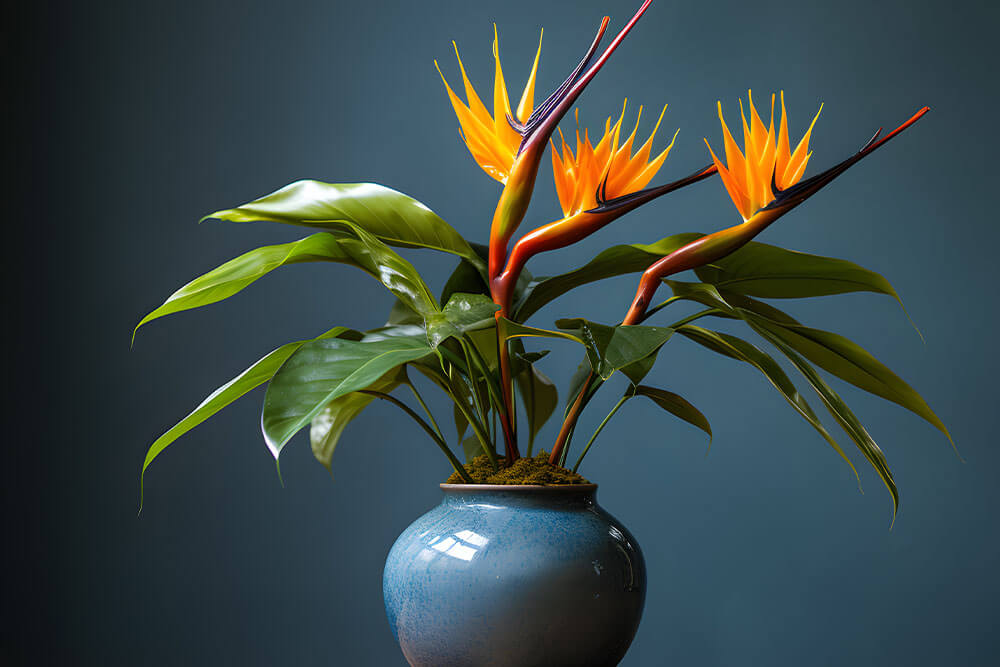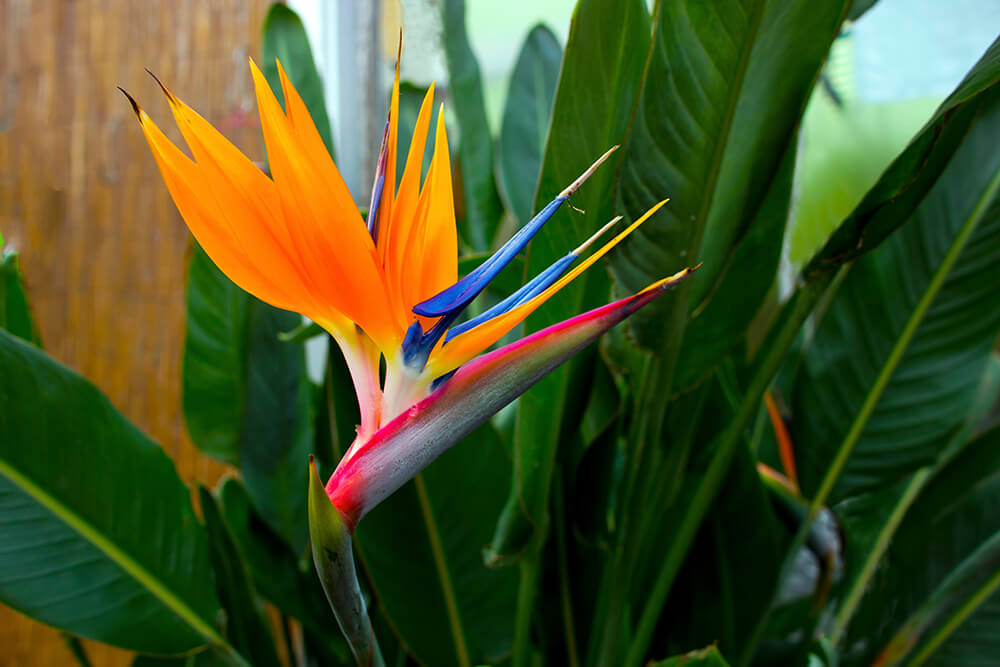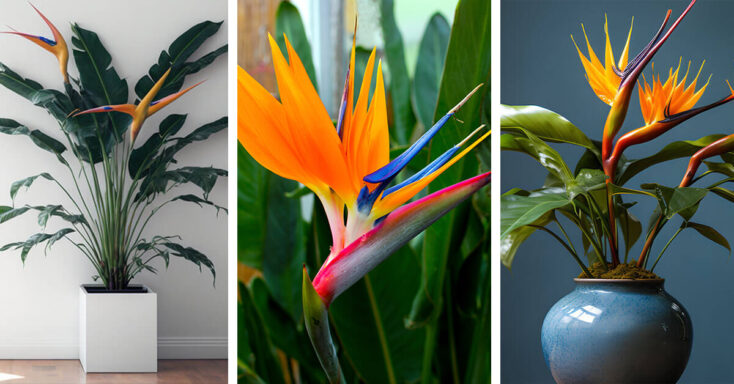Having an indoor Bird of Paradise is like enjoying a trip to tropical locations without ever leaving the comfort of your home. It’s an outstanding bloom, being wholly recognizable, bright, and lush. Also called the Crane Flower, this plant originated in South Africa. It wasn’t introduced to Central and South America until the late 1700s. As for the name? This flower looks like an exotic bird taking flight. Use our guide to master Bird of Paradise plant care!
Key Takeaways
- Birds of Paradise (Crane flower, banana tree) are fast growers and can reach your ceilings before you know it.
- Indoor Birds of Paradise rarely blossom but make up for it with glorious foliage.
- Damp-wipe the leaves of your plant regularly to remove dust and improve photosynthesis.
- A healthy, mature plant can produce up to 36 flower spikes a year.
- Plants grown in partially shady spots will produce larger flowers than the ones planted in full sun.
Breathtaking Birds of Paradise
While not a plant you’d consider suitable for indoors, the giant bird of paradise grows up to 30 feet tall. The various cultivars for this plant have distinctive sizes, colors, and needs. If you give someone starting a new venture a bird of paradise, it brings luck. You need a little patience to grow these. Bird of Paradise can take up to four years to mature and flower.
Botanical Name: King George III had a Queen by the name of Carlote of Mecklenburg-Strelitz. When this glorious flower first arrived in Britain, the royal gardener named it after the Queen. The Genus name, “Strelitzia” remains.
Bird of Paradise Plant Care Indoors

While the bird of paradise plant may look like it’s picky and awaiting the royal treatment, the truth is wholly different. They are reasonably simple plants to care for if you pay attention to their needs. When you purchase your plant, look at the expected leaf size. You’ll need to plan for this once you get it indoors. The fronds need space for proper airflow.
One way of caring for your bird of paradise is by getting a self-watering container. They keep the plant moist, which is this flower’s happy place. The self-watering container removes a lot of guesswork.
The foliage of the bird of paradise requires light access. When you water it, turn the plant about ¼ of the way around clockwise. Do this each time so there is even growth on both sides. Put your plant in an area of your home away from cold drafts. These flowers benefit from humidity, even if it is as simple as a mister. Leaves on this plant split naturally, but moisture reduces it greatly.
Popular Plants: In the area where the majority of birds of paradise grow, they have special standing. They are the official flower of Los Angeles!
Growing Needs of Indoor Bird of Paradise Plant
There are five points important to successfully growing indoor Birds of Paradise.
- Light: These plants love BRIGHT light, but not direct light. Being in the direct sun can burn their leaves. So, look for a spot where indirect sunlight naturally flows through a window (east or west-facing). If your home is dark or gets dark seasonally, consider using a grow light.
- Fertilizer: You won’t need to fertilize this plant often, but an all-purpose blend does the trick (10-10-10).
- Pruning: Keeping your plant tidy also reduces the risk of fungal diseases.
- Temperature: The best heat range for birds of paradise is 65-80F.
- Water & Soil: Use loamy, well-draining potting soil with a pH hovering around 6.5. In terms of water, the more heat/light your plant receives, the more water it needs. Make sure the plant’s soil nearly dries out between waterings.
Bananas and ginger are both close relatives of this plant. The way you propagate them is the same, namely cutting off a rhizome and moving it to fresh potting soil. This method is far faster than growing these flowers from seed. Do not try this when your plant is actively showing new growth.
Begin by lifting the plant gently out of the pot. Cut the rhizome, making sure each piece has a leave and roots attached. After planting, leave it where it receives indirect, low light for 8 weeks so the roots grow strong. Move the plant afterward to an indirect, high-light window.
Types of Bird of Paradise for Your Home

When a Bird of Paradise plant catches your eye, you want to check to see if it suits your indoor landscape.
- Dwarf Orange: A tidy 1-3 feet tall. Has a bright orange spike with blue overtones, blossoming from late winter to early fall. The leaves have blue-green undersides.
- Juncea: One of the most popular among birds of paradise. Its leaves are reed-like and narrow. The plant grows to be 4 feet tall, with flowers measuring 8 inches long. Blossoms from late fall through late spring.
- Mandela’s Gold: As you might expect, this variety has bright yellow flowers that nearly look golden in the sun. The expected mature height is 4-5 feet.
- Mexican Bird of Paradise: A broad leaf evergreen with flowers leaning toward the yellow end of the spectrum. The flowers look like azaleas. You need more space for this plant: 10-15 feet.
- Orange: A brilliant flower attached to 3-foot stalks. The plant grows 6 feet tall and three feet wide.
- Red (Peacock flower, Pride of Barbados): It’s a repeat bloomer with red-orange flowers. They, like the orange variety, resemble azaleas. This might make a stunning high entryway piece (10-20 feet tall).
- White: This bird of paradise features white sepals with purple tongues. The leaves seem gray-green. Mature height 5-7 feet.
- White Flowered Banana Plant: The foliage of this bird of paradise feels almost leathery. The leaves contain green hues and look much like those of a banana plant. Mature height 5-7 feet.
- Yellow Bird of Paradise (bird of paradise bush): A shrub form of this plant, this flowers in July and August with yellow or red blossoms. Mature height: 7-10 feet (perhaps for a foyer).
Symbolism: This plant traditionally represents freedom, excitement, joy, faithfulness, and love (the flower gifted on the ninth wedding anniversary). Spiritually speaking, the flowers are an emblem of good outlooks and transcending difficult situations. In Hawaii, the Bird of Paradise’s name means “little globe,” and it embodies nobility.
Bird of Paradise Watering
Your bird of paradise benefits from filtered water at room temperature. On average, they need water every 1-2 weeks. Test by seeing if the soil’s dry down to 1” in the pot. When you go through a period of higher heat and/or light, the plant becomes more thirsty.
Along with watering, there’s humidity to consider. If you have a humidifier in your home, your plant will thank you. Otherwise, you can use a hand mister regularly.
No flowers? No Problem!: Don’t be terribly disappointed if you don’t get your indoor bird of paradise to flower. It’s not common. There is also timing to consider. A plant receiving consistent care takes five years before it reaches maturity, at which point it flowers regularly.
Potting and Repotting Indoor Bird of Paradise Plants
When you see the roots of your flower sneaking out drain holes, your plant is outgrowing its container. You’ll want a pot about 2-3” larger than the current one. Fill it with cactus potting mix, which drains and dries quickly.
Repotting every two years is the norm. Lay out some paper, and lay the planter on its side. Gently wiggle out the Bird of Paradise. Trim away roots that look soggy or dead. Shake off the old soil. You can also do a quick trim on the foliage at this time.
Put some pebbles at the bottom of the new container, followed by soil. Put the plant on top of the dirt, filling all around it for support. Press down and water thoroughly. Your plant may experience some shock from transplanting. If you see the leaves curling a bit, amend with a little more water.
Eating birds of paradise can be harmful to your pet dog or cat. Signs of ingestion include drowsiness, vomiting, and nausea (with the main culprit being the flower’s fruit and seeds). If you love this plant but can’t be certain of having a safe place for it, think artificial instead.
Indoor Bird of Paradise Pruning and Maintenance
Pruning helps keep your plant to the size you want. Simply remove old leaves, pinch off dead flowers, and look for dead stalks. You don’t have to wait for any special time of year since your plant lives indoors. But if you’re going to do serious pruning, you might want to wait for spring, following Mother Nature’s cue.
If a leaf has over half of the live tissues, retain it. Wait until the brown encompasses more of the foliage. Older plants benefit from trimming and pruning, helping them direct their energy to their healthy parts.
My How Big You Are! The largest species among birds of paradise is the S. nicolai. It grows upward of 33 feet tall. The leaves on Nicolai measure anywhere from 12 to 79 inches long and 4-31 inches wide.

Blooming and Resting Periods
Even indoors, your bird of paradise goes through a resting period during which it needs less water. The included months are October-February, following the decrease of natural light to the planet. Don’t extend the times between watering. Rather, reduce the amount of moisture.
Indigenous artists in Panama use their weaving skills to make things like baskets and mats out of bird of paradise foliage. The methods are generational, with techniques handed down to a family member. The resulting products are durable and versatile.
Common Pests & Plant Diseases of Indoor Bird of Paradise Plant
Scale and mealybugs are the most common when it comes to pests among Bird of Paradise plants. Use a paper towel soaked in isopropyl alcohol and wipe it off your plant. Afterward, use Neem Oil for treatment over several weeks to make sure they stay gone.
And disease? Septoria fungus may manifest. It looks like brown spots on the leaves, edged in red. Remove any infested leaves immediately.
Troubleshooting Common Problems
- Leaning or leggy: your plant needs more sun. Without it, the structure can’t hold stems and leaves, which bend. Move the bird of paradise to a better location.
- Slowed Growth: In winter, you can expect some slowed growth, but beyond that, there may be trouble brewing. Check to see if it gets ample lighting.
- Color Abnormality: Once again, dull brown leaves on your plant imply they’re not getting enough light. Also, it’s important that your flower gets even sunlight on all sides.
- Droopy leaves: While not enough light can be the problem, the plant may not be getting enough water, too. Check the soil.
- Wilting: Too much sunlight. Other signs of excessive light include yellowing leaf edges and slowed growth.
Bird of Paradise in Traditional Medicine: In South Africa, the bird of paradise plant appears in medicine for the treatment of fever, urinary infections, and respiratory infections.
Frequently Asked Questions About Bird of Paradise Clant
Should I remove leaves from the Bird of Paradise?
Removing old plant matter is good for these flowers. Thin out the leaves and remove damaged stems.
What does an overwatered bird of paradise look like?
The plant’s leaves droop, curl, and split excessively. They become brown on the edges and have a yellow line.
How do you rehydrate Bird of Paradise?
When your plant is extremely dry, move the container into a tub (or sink). Fill the sink or tub about 4” deep. Put the plant into the basin, leaving it to soak up water at a natural pace from the drainage hole. Leave it before 45 minutes. You are looking for the water levels in the soil to reach 50%.
What is the best fertilizer for Bird of Paradise?
Be careful. Overfertilization leads to little to no flowering and a ton of foliage. In summer, give the plant a feeding with organic fertilizers, preferably controlled release material with an NPK balance of 3-1-2.
Why are my Bird of Paradise’s leaves turning brown and curling?
Sometimes, a little investigation is involved in figuring out what’s wrong with your plant. This symptom can be a sign of pests, disease, lighting issues, and temperature changes.
Summary
Birds of Paradise are exquisite flowers filled with an air of glamor. They are fast growers, and you will typically need a space with high ceilings for growth to adulthood. While you may not get flowers, the foliage on the Bird of Paradise is exceptional. A developing learner should be able to grow and care for this flower successfully.
Final Thoughts
The first time I saw a Bird of Paradise, I felt awe and appreciation. Unlike some flowers, the petals on this plant did not appear to be the least bit delicate. The entire plant has solid construction. In your home, you can count on them being hardy so long as you follow basic growing guidelines. I think they would look fantastic with an indoor water feature.


